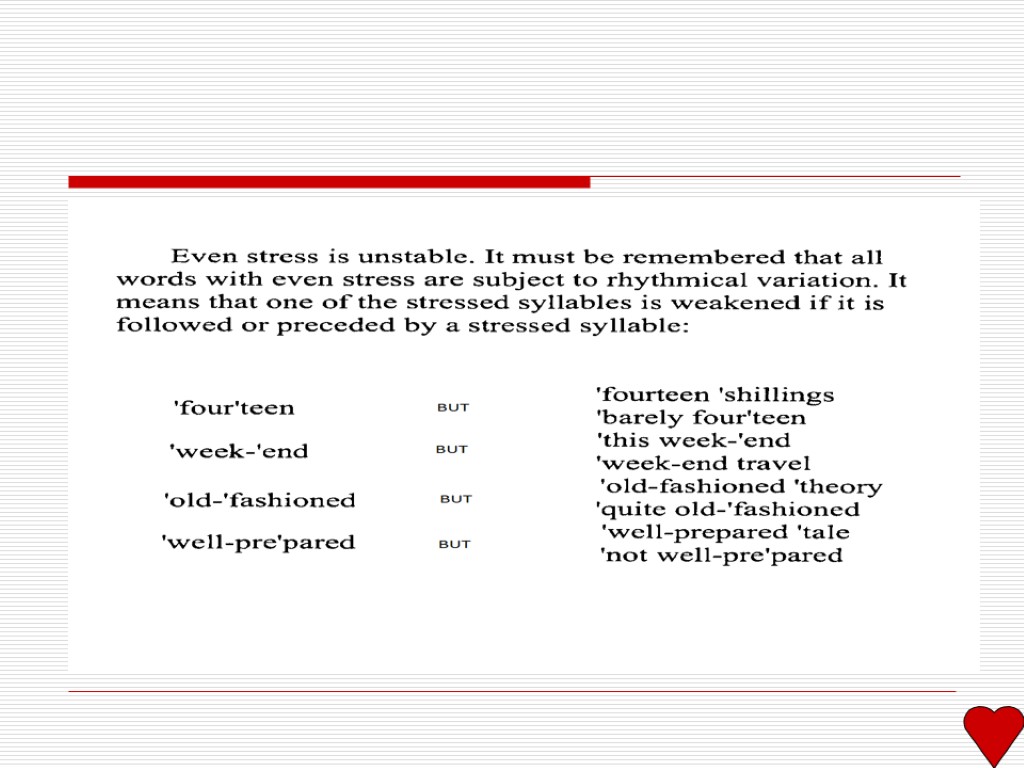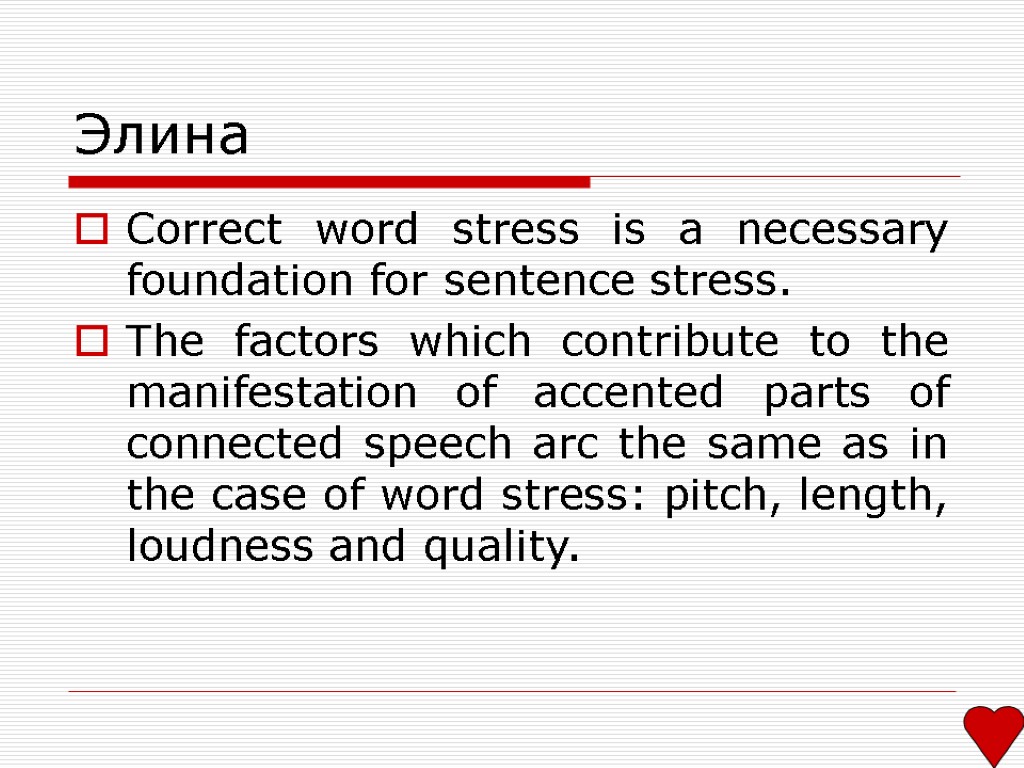Ника Яна Реутова Яна Батаева Элина Таня Лиза


Ника Яна Реутова Яна Батаева Элина Таня Лиза Настя Саша

Ника Stress or accent is defined as a noticeable prominence of some elements of speech continuum. This notion applies both to individual words and to phrases and sentences as polysyllabic words. Thus acoustically, stress results from a stronger effort of articulation. It mayor may not be associated with a change in pitch movement.

It has also been noticed that stressed syllables tend to be longer and louder. The alteration of accented (strong) and unaccented (weak) syllables is found in many languages. In English, stress is particularly important because it can change the meaning of words. cf. 'import - im'port.

Яна Реутова English word stress changes when the word occurs in particular contexts. The rules that govern the changes are few and easy to learn. Each word having two or more syllables has a fixed stress pattern. Stress may be placed on the first, second or third syllable.




There are also a number of simple, derived and compound words pronounced with the so-called "even" stress, or two primary stresses. 'un'known 'chi'nese 'thir'teen 'ca'shier 'i'dea 'week-'end ' old-'fashioned 'well-'prepared 'country-'house 'ginger-'beer 'cotton-'wool 'second- 'hand 'broken-'hearted


Яна Батаева Word stress as opposed to phrasal stress is used to distinguish between compounds and attributive (adjective + noun) word groups.

Even stress in compounds is regularly used: - when the first element denotes material. - when each of the two nouns indicates a different characteristic. - when the semantic relationship between elements is one of belonging (equal to a genitive).

'city 'wall = wall of the city 'week-'end = end of the week 'family 'bible = the bible of the family miscellaneous other groups of compounds, e.g. 'back 'garden 'ground 'floor 'head'master 'arm'chair 'eye-'witness 'coal-'fire 'church 'avenue 'Euston 'station 'Oxford 'Circus 'Hyde 'park

Even stress is also used in compounds with certain prefixes. The negative prefixes dis- and in- (il-, im-, ir-) are stressed if the second element begins with an unstressed syllable, thus dis'courage (one stress) but 'disin'clined, 'inex'pericnccd, 'irre'ligeous (two stresses).

The stress falls on the preceding syllable if the word ends in one of the following suffixes: ity: 'quality, natio'nality, uni'versity ion/ian: dis'cussion, in'tention ic: dra'matic, em'phatic ify: 'terrify, Justify ible: in'credible, 'terrible, in'teligible ish: 'finish, 'publish Polysyllabic words in -ate throw the main stress back two syllables: 'penetrate 'aggrevate 'indicate,

Modern dictionaries of pronunciation often give two variants of stress. hos'pltable - 'hospitable, 'corduroy - cordu'roy, 'deadwood - deadwood. American English is also known for different-from-British accentuation.

Элина Correct word stress is a necessary foundation for sentence stress. The factors which contribute to the manifestation of accented parts of connected speech arc the same as in the case of word stress: pitch, length, loudness and quality.

English is known as a stress-timed language, Stress-timing is defined by P, Roach as "the characteristic of languages which have a tendency for stressed syllables to occur at equal intervals of time."

"You will all have seen from the handouts which you have in front of you that I propose to divide this course of lectures on the urban and architectural development of London into three main sections".

The property of being equally spaced out in time is called isochrony. Isochrony is the term usually used in connection with the description of the rhythm of languages. 'both of them are 'new 'here.

This kind of timing is also known as stress-timed rhythm and is based on the notion of the foot. Experimental research suggests that isochrony is rarely found in natural speech and that (at least in the case of English speakers) the brain judges sequences of stresses to be more nearly isochronous than they really are: the effect is to some extent an illusion.

Таня The notion of isochrony does not necessarily have to be restricted to the intervals between stressed syllables, It is possible to claim that some languages tend to preserve a constant quanti ty for all syllables in an utterance: this is said to result in syllable-timing.

It seems that in languages characterized as stress-timed, there is a tendency for unstressed syllables to become weak, and to contain short, centralized vowels, whereas in languages described as syllable-timed, unstressed vowels tend to retain the quality and quantity found in their stressed counterparts.

An important functional result of stress-timing is that certain grammatical words tend to be unstressed in English sentence.

What must be re'membered about RP is that it is a 'dialect of English, originally 'Southern, which has been used as a standard for 'teaching purposes for nearly 'half a century.

Stress-timing is a very noticeable feature of English pronunciation and must be given sufficient training in language learning. The strict rules of English rhythm allow describing phrases and sentences as having repetitive rhythmical structure which is typical both of isolated articulation and of pronunciation in connected speech: 'Bed and 'breakfast 'Free and 'easy

In the same way it is possible to speak of the rhythm of complex grammatical units. Thus analytical constructions with perfect participles are based on one nuclear stress and should be practiced as such: You should have done it He must have already come

Лиза The nature of stress is simple enough and most people feel they have some sort of idea of what the difference is between stressed and unstressed syllables, though they might explain it in many different ways.

we can study stress from the point of view of production and of perception; the two are obviously closely related, but are not identical. The production of stress is generally believed to depend on the speaker using more muscular energy than is used for unstressed syllables.

Measuring muscular effort is difficult, but it seems possible, according to experimental studies, that when we produce stressed syllables, the muscles that we use to expel air from the lungs are more active, producing higher subglottal pressure. It seems probable that similar things happen with muscles in other parts of our speech apparatus.

Many experiments have been carried out on the perception _ of stress, and it is clear that many different sound characteristics_are important in making a syllable recognizably stressed. From the perceptual point of view, all stressed syllables have one characteristic in common, and that is prominence; stressed syllables are recognized as stressed because they are more prominent than unstressed syllables.

Настя What makes a syllable prominent? At least four different factors are important. Prominence, then, is produced by four main factors: (I) loudness, (II) length, (III) pitch and (IV) quality. Generally these four factors work together in combination, though syllables may sometimes be made prominent by means of only one or two of them.

Experimental work has shown that these factors are not equally important; the strongest effect is produced by pitch, and length is also a powerful factor. Loudness and quality have much less effect. (Roach 1993, p.85)

I) Most people seem to feel that stressed syllables are louder than unstressed: in other words, loudness is a component of prominence.

II) The length of syllables has an important part to play in prominence. If one of the syllables in our "nonsense word" ba:ba:ba:ba: is made longer than the others, there is quite a strong tendency for that syllable to be heard as stressed.

III) If one syllable of our "nonsense word" To place some movement of pitch (e.g. rising or failing) on a syllable is even more effective.

IV) A syllable will tend to be prominent if it contains a vowel that is different in quality from neighboring vowels.

Саша It has often been claimed that Enghsh speech IS rhythmical, and that the rhythm is detectable in the regular occurrence of stressed syllables; of course, it is not suggested that the timing is as regular as a clock - the regularity of occurrence is only relative.

The theory that English has stresstimed rhythm implies that stressed syllables will tend to occur at relatively regular intervals whether they are separated ~y unstressed syllables or not; this would not be the ~ase l.n "mechanical speech".

1 2 3 4 5 'Walk 'down the 'path to the 'end of the ca'nal

The stress-timed rhythm theory states that the times from each stressed syllable to the next will tend to be the same, irrespective of the number of intervening unstressed syllables.

The theory also claims that while-some languages ) have stress-timed rhythm similar to that of English, others (such as French, Telugu and Yoruba) have a different rhythmical structure called syllable-timed rhythm; in these languages, all syllables, whether stressed or unstressed tend to occur at regular time-intervals and the time between stressed syllables will be shorter or longer in proportion to the num~er of unstressed syllables.

Some writers have developed theones of English rhythm in which a unit of rhythm, the foot, is used (with an obvious parallel in the metrical analysis of verse); the foot begins with a stressed syllable and includes all following unstressed syllables up to (but not including) the following stressed syllable. The example sentence given above would be divided into feet as follows:
presentation.ppt
- Количество слайдов: 42

